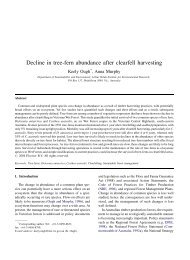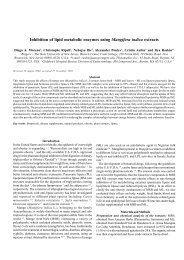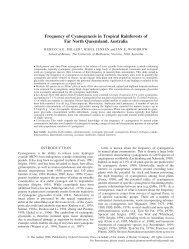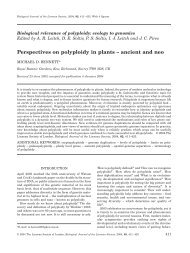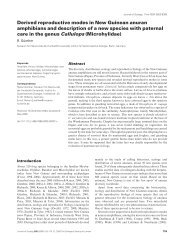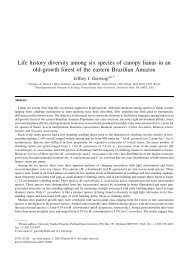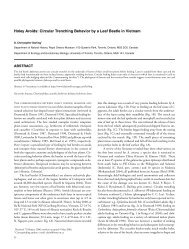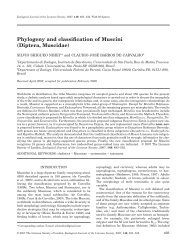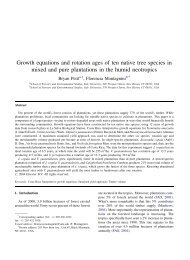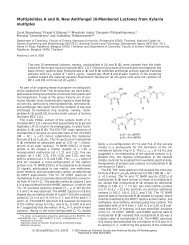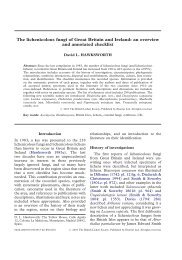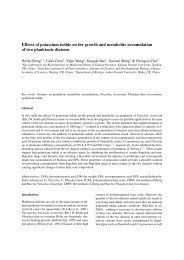Lichens and higher plants on stone: a review - AseanBiodiversity.info
Lichens and higher plants on stone: a review - AseanBiodiversity.info
Lichens and higher plants on stone: a review - AseanBiodiversity.info
Create successful ePaper yourself
Turn your PDF publications into a flip-book with our unique Google optimized e-Paper software.
Fig. 4. Distributi<strong>on</strong> of 12 lichen communities <strong>on</strong> acid rock of a Sardinian “nuraghe”. A: upper part of the nuraghe; B: lower part of the nuraghe.<br />
Phaeophyscia orbicularis, Xanthoria c<str<strong>on</strong>g>and</str<strong>on</strong>g>elaria <str<strong>on</strong>g>and</str<strong>on</strong>g> Caloplaca<br />
citrina showed that nutrient enrichment of the st<strong>on</strong>e<br />
substrate had caused lichen growth. The nitrates were attributed<br />
to fertilizers dusted <strong>on</strong> crops in the surrounding elds.<br />
On the tower of the Cathedral of Seville, la Giralda, calcicolous<br />
species (almost all crust-like <str<strong>on</strong>g>and</str<strong>on</strong>g> epilithic) have<br />
been identi ed. Their growthis associated withbird excrement.<br />
These species usually live <strong>on</strong> deteriorated calcareous<br />
substrates (Saiz-Jimenez, 1981).<br />
On the pavement mosaics of the Romanesque town of<br />
Italica (Seville), the tesserae <str<strong>on</strong>g>and</str<strong>on</strong>g> mortar were attacked by<br />
Aspicilia radiosa, Aspicilia ho mannii <str<strong>on</strong>g>and</str<strong>on</strong>g> several species<br />
of the genus Caloplaca (Garcia Rowe <str<strong>on</strong>g>and</str<strong>on</strong>g> Saiz-Jimenez,<br />
1988).<br />
2.5. Methods of preventi<strong>on</strong> <str<strong>on</strong>g>and</str<strong>on</strong>g> c<strong>on</strong>trol<br />
The opportunity of removing lichens from st<strong>on</strong>e substrates<br />
must be evaluated case by case, since the damage caused<br />
by eachspecies is di erent. The rst step is to identify <str<strong>on</strong>g>and</str<strong>on</strong>g><br />
perform an ecological characterizati<strong>on</strong> of the species so as to<br />
be able to choose a speci c agent to eliminate the lichen <str<strong>on</strong>g>and</str<strong>on</strong>g><br />
the cause of its growth. Foliose <str<strong>on</strong>g>and</str<strong>on</strong>g> fruticose lichens have<br />
very di erent sensitivities to chemical agents (Giacobini et<br />
al., 1979). If the factors favoring lichen growth are known,<br />
preventive measures can be suggested to halt or slow down<br />
processes of col<strong>on</strong>izati<strong>on</strong>.<br />
Before removing nitrophilic species, which are relatively<br />
fast-growing <str<strong>on</strong>g>and</str<strong>on</strong>g> cause substantial damage, it is advisable<br />
to nd a way of avoiding nitrate enrichment of the st<strong>on</strong>e<br />
surfaces. This can be achieved by c<strong>on</strong>trolling the bird populati<strong>on</strong>s<br />
of towns, the use of fertilizers in nearby elds,<br />
<str<strong>on</strong>g>and</str<strong>on</strong>g> water ow over the surfaces. Water run-o is generally<br />
avoided by sheltering or re-directing the water (Nimis <str<strong>on</strong>g>and</str<strong>on</strong>g><br />
M<strong>on</strong>te, 1988).<br />
For surfaces col<strong>on</strong>ized by endolithic lichens, Nimis <str<strong>on</strong>g>and</str<strong>on</strong>g><br />
Zappa (1988) advise against eliminati<strong>on</strong>, as degenerati<strong>on</strong> of<br />
the thallus leaves the surface porous <str<strong>on</strong>g>and</str<strong>on</strong>g> more vulnerable<br />
to envir<strong>on</strong>mental acids, whereas the damage caused by the<br />
lichens is limited due to their extremely slow growth.<br />
In the past, normal restorati<strong>on</strong> practice involved the mechanical<br />
removal of the lichen thalli. Today this is d<strong>on</strong>e<br />
<strong>on</strong>ly for foliose <str<strong>on</strong>g>and</str<strong>on</strong>g> fruticose lichens since they do not<br />
adhere str<strong>on</strong>gly to the substrate. Mechanical removal of<br />
crust-like lichens, the thallus of which penetrates deeply<br />
into the st<strong>on</strong>e, requires the use of hard brushes <str<strong>on</strong>g>and</str<strong>on</strong>g> much<br />
washing with water <str<strong>on</strong>g>and</str<strong>on</strong>g> detergents. This process disperses<br />
the spores <str<strong>on</strong>g>and</str<strong>on</strong>g> causes much st<strong>on</strong>e to be lost. To avoid these<br />
problems, Clarke (1976) advised applying an amm<strong>on</strong>ium<br />
hydroxide soluti<strong>on</strong> to kill the thalli <str<strong>on</strong>g>and</str<strong>on</strong>g> loosen them, before<br />
mechanical removal. Nimis et al. (1987) advised against<br />
mechanical removal of thalli with soredia in order to avoid<br />
dispersal of these asexual reproductive structures <str<strong>on</strong>g>and</str<strong>on</strong>g> spread<br />
of the lichens.<br />
<str<strong>on</strong>g>Lichens</str<strong>on</strong>g> are generally removed by applicati<strong>on</strong> of chemical<br />
products (see Appendix A) which may be combined<br />
with mechanical methods. A large variety of biocides that<br />
damage either the phycobi<strong>on</strong>t (algicides) or the mycobi<strong>on</strong>t<br />
(fungicides) are available (Lloyd, 1971). The most<br />
important parameters to c<strong>on</strong>sider in the choice of products<br />
to use for restorati<strong>on</strong> are e cacy, n<strong>on</strong>reactivity with<br />
the substrate <str<strong>on</strong>g>and</str<strong>on</strong>g> toxicological characteristics. E cacy<br />
against the lichen should be a maximum at the minimum<br />
dose. The biocides should be of broad spectrum <str<strong>on</strong>g>and</str<strong>on</strong>g> have<br />
a l<strong>on</strong>g-lasting e ect. Chemical soluti<strong>on</strong>s should have a<br />
neutral pH to avoid corroding the st<strong>on</strong>e <str<strong>on</strong>g>and</str<strong>on</strong>g> interfering<br />
with any soluble salts (Richards<strong>on</strong>, 1976). They should<br />
not cause changes in color, loss of translucence, whitening<br />
or increased re ectance. Richards<strong>on</strong> (1976, 1987) advises<br />
against the use of copper compounds <str<strong>on</strong>g>and</str<strong>on</strong>g> phenols because<br />
they color the substrate, <str<strong>on</strong>g>and</str<strong>on</strong>g> of borates that favor the formati<strong>on</strong><br />
of soluble salts. For vast areas it is preferable to<br />
use low toxicity products (Class III or IV, expressed as<br />
LD50 or LC50) so as to avoid c<strong>on</strong>taminati<strong>on</strong> of the envir<strong>on</strong>ment<br />
<str<strong>on</strong>g>and</str<strong>on</strong>g> pois<strong>on</strong>ing of the operators. Biocides may be<br />
applied by spraying, brushing or pasting. Spraying should




